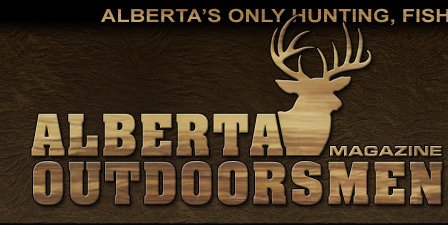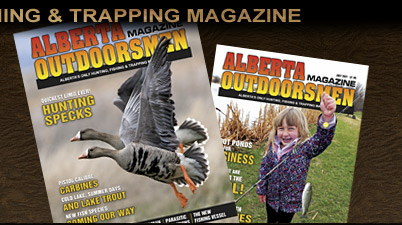|
 |
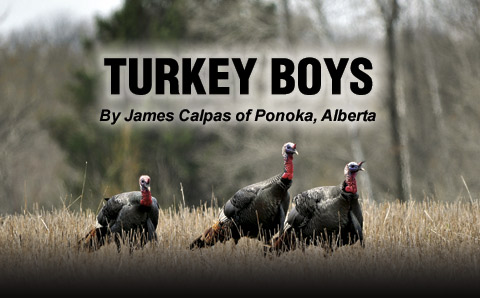 |
All it takes is a phone call to make things happen. Brother Dean called to say that I should consider visiting him the coming May to hunt wild turkeys. He said that unless we made an effort to get together to do some hunting, we never would. For me, bonding with my brother and hunting turkeys meant some serious planning and commitment because Dean lives an hour or so west of Minneapolis, Minnesota.
One twist that Dean added was that we should hunt these wild turkeys using our bows “just to make it a little more interesting”. As it turned out, he was right. Not only did it prove to be a challenge, it also became a passion, bordering on obsession, for both of us. It has been “interesting” to say the least.
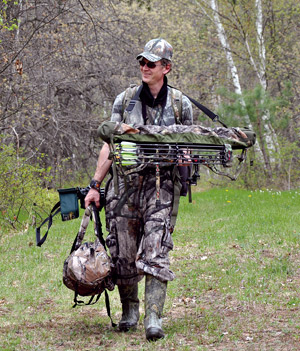 |
| Dean lugging gear into the field to set up. |
Alberta offers hunting opportunities for Merriam’s turkeys (Meleagris gallopavo merriami) in the province through a special licence draw. But heading south for turkeys offered the opportunity to hunt turkeys without having to wait to be drawn and might be an incentive to hunt with my brother, perhaps every year.
Travel and hunting plans were hatched over the winter and within an hour of my arrival at the Minneapolis-St. Paul Airport that day in May 2009; I had my over-the-counter spring turkey bowhunting licence in hand.
Minnesota’s birds are eastern wild turkeys (Meleagris gallopavo silvestris) and were once extirpated. In 1973, the Minnesota Department of Natural Resources (MDNR) released 29 wild turkeys in the southeast of the state. Today, there are now 70,000 birds that continue to increase and expand in range. We would be hunting turkeys in Sherburne and Wright counties midway up the state within the Eastern Broadleaf Forest Province, close to the northernmost range of wild turkey in the state.
The Minnesota spring turkey season bag limit is “one wild turkey with a visible beard”. Mature male birds, toms and juvenile males, jakes, generally both have beards. The beard is an appendage that protrudes from the turkey’s chest. It looks and feels like coarse long hairs and is usually bigger and longer on mature toms. Toms and jakes are generally darker in colour, brown black, while hens are grey. However, we have seen dark brown hens and hens can also have beards.
Turkeys are big birds, and toms can reach over13 kilograms. However, a turkey’s vitals target zone is about the size of a soft ball. Bowhunters have to be able to confidently identify and hit this target zone. It can be challenging, especially when a tom is in full strut with its body hunched and feathers all puffed up, adding an additional 10 to 15 centimetres to its profile and making it all the more difficult to target the vitals. It can be less difficult to take the shot when the tom is not strutting, when shooting broadside the target is where the wing meets the body. The excitement factor also has to be managed, at least it does for me, as a tom dancing in full dress amongst the decoys can send your heart rocketing.
Turkeys are wary birds, but fortunately, toms can drop their guard during the breeding season. They generally disregard ground blinds, but this cannot be taken for granted. Turkeys have outstanding vision and are quick at detecting movement, and they have excellent hearing. A challenge at the best of times and we were going to hunt with bows.
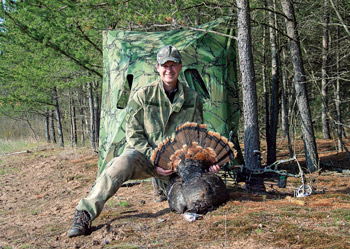 |
| Dean with his 2018 bird. |
That first evening and the next day were spent catching up on things, getting our gear together, shooting our bows, and generally preparing ourselves. Dean had acquired all the gear we needed including box calls, slate calls and a variety of decoys. He had been scouting and obtained access to a few fields where we could hunt. We would be hunting out of ground blinds to allow us to draw our bows while minimizing the possibility of the turkeys seeing our movements.
The following morning, we were set up in one of the fields before early light. The only turkeys we saw that day were our decoys. There were turkey tracks almost everywhere we looked, but for all our calling that day, we heard not a single gobbler that even remotely sounded like it was in our neighbourhood. After putting five hours in the blind, we packed up and decided to check the other fields that Dean had lined up. We’ve since learned that you can get a chance at birds anytime of the day. The limiting factor is primarily how long a hunter is willing to sit in a blind. Don’t get me wrong, we have gone many hours over a number of days without getting an opportunity at a bird.
Over the coming days, we got smarter about how we set up for the birds. We had turkeys coming into our decoys, often jakes and hens. We also had some toms coming our way but not into the decoys. We planned our shots to be around 20 yards and we knew the distances to all our decoys so that we could easily range any inbound toms. We hunted for 10 days and no birds were taken that year, 11 years ago! But we learned a lot.
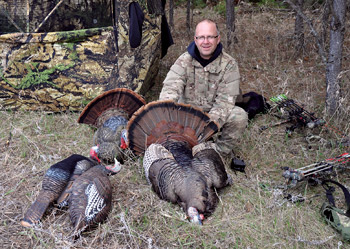 |
| The author with his first Minnesota trukey taken in 2014. |
Peak breeding time depends on the weather and you can be off a bit, but toms are generally game for breeding throughout May. The earlier it warms in spring, the earlier they get the bulk of their breeding done. If you hit the sweet spot in the breeding season, the experience can be spectacular, as toms can come into your spread and beat up your tom and jake decoys. Other times, tom and jake decoys put toms off and switching out to a less imposing tom or jake decoy might be what it takes. Hunters have to be willing to change up the decoy spread as necessary, including going to all hens or using fewer decoys, or using an assortment of hen decoys. Common hen decoys include feeding, standing guard and sitting flat on the ground in the breeding position. Sometimes live hens can bring the toms into your decoys; however, hens can also lead them away.
Hunters who call well can bring a turkey in from a long ways. I’ve seen Dean call a tom in that I had glassed over a kilometre away. We have also watched birds stretch out to look in our direction when we called, listen to what we had to offer by way of clucks, purrs and yelps, only to see it drop down close to the ground to head anywhere else but to where we were. Gobble calls can really get a tom’s attention, and they will gobble back, but it is the sweet, hen purrs and clucks that generally brings them in close, for us anyway.
Dean got his first tom in year four. I got my first tom in the afternoon of the first day in year six! Dean’s calling was textbook and the bird came right in without a blink. We knew there were still more turkeys around. We had seen a curious group of three toms twice earlier in the day that we named the “Turkey Boys”. They just looked like they owned the field. After I retrieved my bird, we packed up and went home excited about the day and our prospects for the next day. Maybe we would both get birds this year.
 |
| The author with his second bird, 2017. |
On day two, we set up at 6:00 am and added a smallish jake decoy in our spread that Dean had purposely included. The Turkey Boys showed up and started to come towards our spread about three hours later. Dean then said he was hoping these boys would start to beat up on our jake decoy so that I could get some good pictures. When they were in the decoys, 20 yards from the blind, I gave him a hard whisper to “shoot one of those birds!” He said that it was only day two, and that he still had nine more days to get a bird. He passed on shooting that day and though we saw the Turkey Boys every day we were out there, they would not come close enough for a shot. You have to try to capitalize on every chance you are offered. Dean did not get his turkey that year. I didn’t even get pictures of the Turkey Boys hammering on the jake.
Dean filled his tag five times over the eleven consecutive years we’ve hunted together and I have two toms. The MDNR reports that in 2019 the bowhunting success rate was 15 percent, so I am ahead of the average and Dean is practically at the top of the charts! The shotgun success rates ranged from 22 to 27 percent from 2010 to 2019. We are hooked on turkey bowhunting. It has also allowed us to get together more often than we otherwise would have and spend more time together pursuing a shared passion.
Not everyone has the opportunity to go to Minnesota and get free room and board and a guide. However, there are turkeys in Alberta and there is a season. If you are looking to expand your hunting experiences, perhaps consider a turkey hunt. ■
For previous Reader Stories click here.
|
|
|
|

